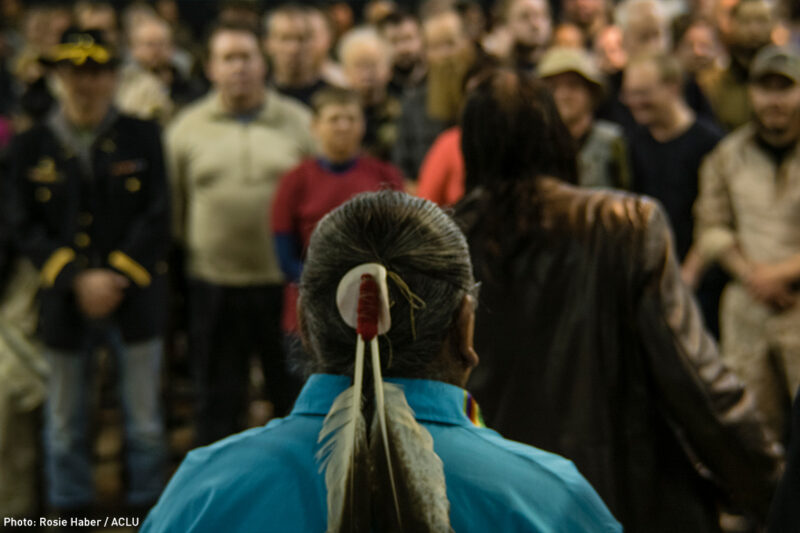Oil and Water Donโt Mix: Why the ภฯฐฤรลฟชฝฑฝแน๛ Is Standing Up for the Standing Rock Sioux Tribe


On December 4, the Army Corps of Engineers by refusing to give Energy Transfer Partners permission to build a portion of the nearly 1,200-mile-long Dakota Access Pipeline under Lake Oahe in North Dakota. The corpsโ decision to perform an environmental impact assessment and explore alternative routes for the pipeline fulfilled the U.S.'s treaty obligations with the Standing Rock Sioux Tribe, which vigorously protested the pipeline out of a credible fear that it could rupture and destroy its water supply, as well as acted in accordance with this nation's environmental protection laws. It was a big win for the tribe and its supporters.
But it didnโt last long.
Days after President Trump took office, he issued a and an asking the corps to expedite its consideration of the companyโs application for an easement to start construction. Soon after, the corps withdrew its call for the environmental study, and Energy Transfer Partners began drilling the next day. The reversal was a slap in the face of the tribe and its treaty rights with the United States. Quickly, the Standing Rock Sioux asked the courts to intervene and stop the pipeline so its impact on the environment could be assessed.
The courts are now the Standing Rock Siouxโs last hope to get the pipeline routed around its land.
Thatโs why this week the ภฯฐฤรลฟชฝฑฝแน๛ signed onto a friend-of-the-court brief with 34 Indian tribes and other organizations in support of a case filed by the Standing Rock Sioux Tribe in federal court against the Army Corps of Engineers. The tribeโs lawsuit seeks to halt further drilling and construction of the pipeline until the corps conducts a proper environmental impact statement consistent with federal statutes, such as the National Environmental Policy Act, as well as the federal governmentโs responsibility to protect the tribeโs rights and sovereignty under the 1868 Treaty of Fort Laramie.
The federal government has once again betrayed the Standing Rock Sioux.
As outlined in our brief, the pipeline should be halted immediately consistent with the Standing Rock Siouxโs treaty rights as well as to prevent, for good, any chance a pipeline leak or rupture could despoil the tribeโs land and water. Energy Transfer Partners, however, claims that the chance of a rupture in the river is low, but there are three responses to that claim.
First, the chance of a rupture isnโt that low. In July 2015, the Michigan Petroleum Pipeline Task Force a comprehensive report of pipeline failures. The study found โhundredsโ of pipeline ruptures โthat have occurred throughout the U.S. pipeline system.โ
The report cites many examples of ruptures over the last few years. In May 2015, a pipeline failed off the coast of Santa Barbara, California, releasing 105,000 gallons of oil into the Pacific Ocean. A few months earlier, another pipeline spill released 42,000 gallons of oil underneath the Yellowstone River. Two years earlier, a pipeline ruptured in Mayflower, Arkansas, releasing 134,000 gallons. In July 2010, a pipeline break released 840,000 gallons of oil, fouling 38 miles of the Kalamazoo River in Michigan.
Second, the possibility of a rupture โ whether low or not โ must be considered together with the consequences of a rupture. Even a โmoderateโ release of oil into the Missouri River would have profound and devastating consequences, a subject that the companyโs press releases ignore.
Lastly, it is fair to ask: Who would suffer the most by a rupture? The immediate victims of a rupture of the pipeline would be the members of the Standing Rock Sioux Tribe, now that the pipeline has been moved into their watershed. But the degradation of the water would also impact some 18 million people downstream who depend on water from the Missouri River.
Since 1974, itโs been the ภฯฐฤรลฟชฝฑฝแน๛โs national policy to support Native Americansโ right to a tribal land base and its natural resources as well as support tribes who press their treaty rights with the U.S. government. Under treaties the Standing Rock Sioux made with the U.S. government as well as under federal statutes, the tribe has the right to protect its land, its heritage, and its water from contamination by a possible pipeline rupture. The treatment of the Standing Rock Sioux by Energy Transfer Partners and all levels of government compel us to help the tribe as they fight to stop the pipeline construction from proceeding so that a simple environmental impact assessment can be conducted.
The federal government has once again betrayed the Standing Rock Sioux and made a mockery of its obligations to the tribe while jeopardizing the drinking water of over 18 million Americans. We hope our brief helps convince the courts that a great injustice is taking place on federal land just north of the Standing Rock Siouxโs territory and that it should be stopped immediately.
Stephen L. Pevarโs book, โThe Rights of Indians and Tribesโ (Oxford 2012), is available .

